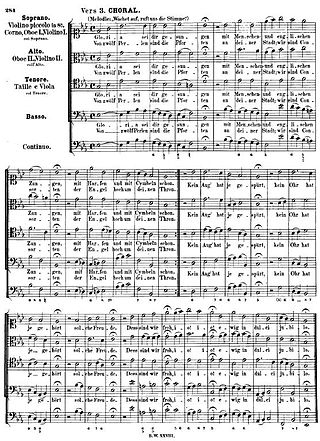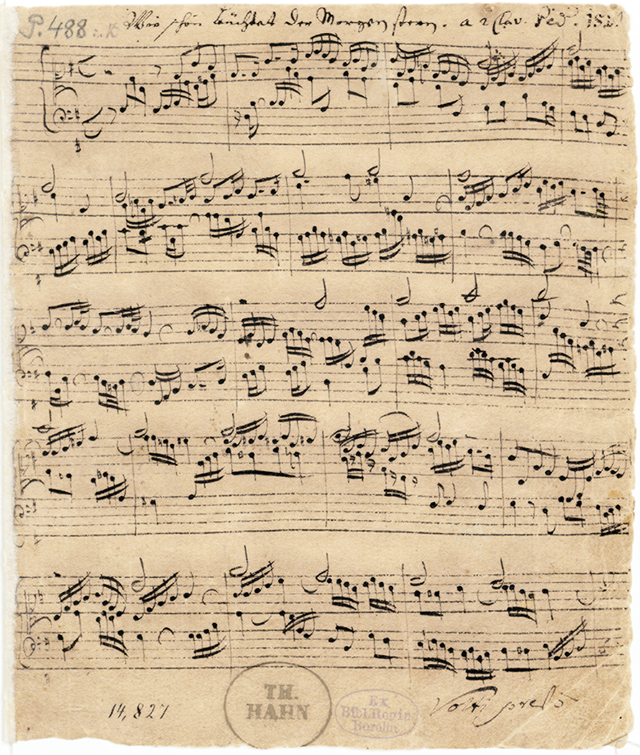Top Qs
Timeline
Chat
Perspective
Lutheran chorale
Musical setting of a Lutheran hymn From Wikipedia, the free encyclopedia
Remove ads
A Lutheran chorale is a musical setting of a Lutheran hymn, intended to be sung by a congregation in a German Protestant church service. The typical four-part setting of a chorale, in which the sopranos (and the congregation) sing the melody along with three lower voices, is known as a chorale harmonization. The practice of singing in unison was the rule of the reformed churches, both in Germany and in other countries.[1]

Remove ads
Lutheran hymns
Summarize
Perspective
Starting in 1523, Martin Luther began translating worship texts into German from the Latin.[2] He composed melodies for some hymns himself, such as "Ein feste Burg ist unser Gott" ("A Mighty Fortress Is Our God"), and even a few harmonized settings.[3] For other hymns he adapted Gregorian chant melodies used in Catholic worship to fit new German texts, sometimes using the same melody more than once.[citation needed] For example, he fitted the melody of the hymn "Veni redemptor gentium" to three different texts, "Verleih uns Frieden gnädiglich", "Erhalt uns, Herr, bei deinem Wort", and "Nun komm, der Heiden Heiland".[2] The first Lutheran hymns were published in 1524.[4] These included the Achtliederbuch (known as the first Lutheran hymnal) and the Erfurt Enchiridion (both with unaccompanied melodic settings), as well as Johann Walter's Eyn geystlich Gesangk Buchleyn, the first to contain part song settings of Lutheran hymns.[2][5]
Luther and his contemporaries referred to these vernacular hymns as geistliche Lieder (spiritual songs), Psalmen (psalms), christliche Lieder (Christian songs), and geistliche (or christliche) Gesänge or Kirchengesänge. The German word Choral, which was originally used to describe Latin plainchant melodies, was first applied to the Lutheran hymn only in the later sixteenth century.[2]
In the modern era,[6] many Lutheran hymns are used in Protestant worship, sometimes sung in four-part harmony. A four-part harmony is the traditional method of organizing chords for 4 different voice ranges: soprano, alto, tenor and bass (known together as 'SATB'). The term 'voice' or 'part' refers to any musical line whether it is a melody sung by singers, a long note played on an instrument or anything in between.[7]
Remove ads
Composers
Summarize
Perspective
This section needs additional citations for verification. (September 2020) |
Composers of tunes for Lutheran hymns, or who adopted such tunes in their compositions:[8]
- Martin Luther (1483–1546)
- Johann Walter (1496–1570)
- Sebald Heyden (1499–1561)
- Nikolaus Herman (c. 1500–1561)
- Johannes Hermann (1515–1593)
- Nikolaus Selnecker (1530–1592)
- Cyriakus Schneegass (1546–1597)
- Joachim a Burck (1546–1610)
- Philipp Nicolai (1556–1608)
- Bartholomäus Gesius (c. 1562–1613)
- Michael Praetorius (1571–1621)
- Melchior Franck (c. 1579–1639)
- Melchior Teschner (1584–1635)
- Michael Altenburg (1584–1640)
- Heinrich Schütz (1585–1672)
- Johann Hermann Schein (1586–1630)
- Samuel Scheidt (1587–1654)
- Johann Schop (c. 1590–1667)
- Heinrich Scheidemann (c. 1595–1663)
- Johann Crüger (1598–1662)
- Andreas Hammerschmidt (1611/1612–1675)
- Dieterich Buxtehude (c. 1638–1707)
- Gottfried Vopelius (1645–1715)
- Johann Pachelbel (1653–1706)
- Johann Sebastian Bach (1685–1750) harmonised hundreds of chorales, typically used at the end of his cantatas and concluding scenes in his Passions. In his St Matthew Passion, he set five stanzas of "O Haupt voll Blut und Wunden" in four different ways. He also used hymns as the base for his cycle of chorale cantatas and chorale preludes. Bach concentrated on the chorales especially in the Chorale cantatas of his second annual cycle, composed mostly in 1724/25.
- Felix Mendelssohn (1809–1847)
- Anton Bruckner (1824–1896).[9]
- Johannes Brahms (1833–1897)
- Max Reger (1873–1916)
- Sigfrid Karg-Elert (1877–1933)
- Igor Stravinsky (1882–1971)
- Ernst Pepping (1901–1981)
- Hugo Distler (1908–1942)
- Sofia Gubaidulina (1931–2025)
- George C. Baker (b. 1951)
Remove ads
Compositions based on Lutheran chorales
Summarize
Perspective
This section has multiple issues. Please help improve it or discuss these issues on the talk page. (Learn how and when to remove these messages)
|

Vocal
Organ
Chorales also appear in chorale preludes, pieces generally for organ originally designed to be played immediately before the congregational singing of the hymn, but developed into an autonomous genre by north-German composers of the middle and late 17th century, particularly Dieterich Buxtehude.[10] A chorale prelude includes the melody of the chorale, and adds contrapuntal lines. One of the first composers to write chorale preludes was Samuel Scheidt. Bach's many chorale preludes are the best-known examples of the form. Later composers of the chorale prelude include Johannes Brahms, for example in his Eleven Chorale Preludes, and Max Reger who composed many examples, including Wie schön leucht' uns der Morgenstern (based on the hymn by Philipp Nicolai). In the 20th century, important contributions to the genre were made by Hugo Distler and Ernst Pepping.[10]
Other instrumental
- Sofia Gubaidulina – Meditation über den Bach-Choral "Vor deinen Thron tret' ich hiermit", for harpsichord, two violins, viola, cello, and contrabass (1993)
Scholarship
This section needs expansion. You can help by adding to it. (October 2017) |
Scholarship regarding Lutheran chorales intensified from the 19th century.
Carl von Winterfeld
The musicologist Carl von Winterfeld published three volumes of Der evangelische Kirchengesang und sein Verhältniss zur Kunst des Tonsatzes (Evangelical church-song and its relation to the art of composition) from 1843 to 1847.[11]
Zahn's classification of chorale tunes
Johannes Zahn published Die Melodien der deutschen evangelischen Kirchenlieder (the tunes of the German Evangelical hymns) in six volumes from 1889 to 1893.[12]
Remove ads
References
Sources
Further reading
External links
Wikiwand - on
Seamless Wikipedia browsing. On steroids.
Remove ads
